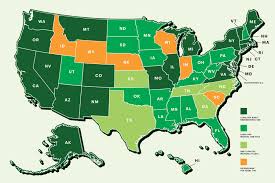Weed Legalization Map, In recent years, the global perspective on cannabis has shifted significantly, driven by evolving attitudes, legal reforms, and increased awareness of its medical and recreational benefits. The concept of a “weed legalization map” has become a valuable tool for understanding how different regions approach cannabis use and regulation. This article explores the current state of weed legalization around the world and highlights key trends and developments.
The Rise of Cannabis Legalization
Cannabis legalization has seen remarkable progress since the early 2000s, with many countries and states reassessing their policies. The transformation from a largely prohibited substance to a regulated and legal one reflects a broader change in public perception and policy. The legalization trend can be categorized into several areas:
- Medical Use: Many countries have embraced cannabis for medical purposes, recognizing its potential benefits for treating various conditions such as chronic pain, epilepsy, and multiple sclerosis. The legalization of medical cannabis often serves as a precursor to broader legalization efforts.
- Recreational Use: Recreational cannabis use has become increasingly accepted in various regions. In places like Canada and several U.S. states, cannabis has been legalized for adult use, leading to new regulatory frameworks, tax revenues, and changes in social norms.
- Decriminalization: In some regions, cannabis remains illegal but has been decriminalized. This approach reduces legal penalties for possession and use but does not fully legalize the substance. Decriminalization is often seen as a step towards more comprehensive reforms.
Mapping the Legal Landscape
Creating a “weed legalization map” involves examining the status of cannabis laws across different countries and regions. Here’s an overview of the current landscape:
- North America: The United States has seen a patchwork of legalization efforts, with states like Colorado, California, and New York leading the way in recreational legalization. Canada has fully legalized cannabis nationwide, setting a precedent for other countries. Mexico and Uruguay are also notable for their progressive cannabis laws.
- Europe: Europe exhibits a diverse range of cannabis policies. The Netherlands is famous for its tolerant approach to cannabis use in designated “coffeeshops.” Meanwhile, countries like Germany and Malta have embraced medical cannabis, with discussions ongoing about recreational legalization. Portugal has adopted a decriminalization model, focusing on harm reduction rather than criminal penalties.
- South America: Several South American countries are exploring or implementing cannabis reforms. Uruguay stands out as the first country to fully legalize cannabis, while nations like Colombia and Brazil are advancing medical cannabis initiatives.
- Asia: Cannabis laws in Asia tend to be stricter, with most countries maintaining strong prohibitions. However, there are emerging discussions in countries like Thailand, which recently legalized medical cannabis and is considering broader reforms.
- Africa: The African continent shows a mix of approaches. South Africa has legalized cannabis for personal use, and Lesotho has become a hub for legal cannabis cultivation. Other countries are still debating their cannabis policies or maintaining strict prohibitions.
Future Trends and Challenges
The landscape of cannabis legalization is dynamic and continues to evolve. Future trends may include:
- Increased Global Coordination: As more countries consider cannabis reform, there may be efforts to harmonize regulations and create international standards.
- Economic Impacts: The economic benefits of legalization, including job creation, tax revenue, and reduced law enforcement costs, will likely continue to drive legalization efforts.
- Public Health and Safety: Ongoing research into the health impacts of cannabis will shape future policies, with a focus on ensuring safe use and minimizing risks.
- Social Justice: Addressing the social justice aspects of cannabis reform, including expunging criminal records and supporting communities affected by previous drug laws, will be crucial for comprehensive legalization efforts.
Conclusion
The “weed legalization map” provides a snapshot of how different regions are approaching cannabis regulation and reflects broader shifts in public attitudes and policy. As the conversation around cannabis continues to develop, staying informed about global trends and local laws will be essential for understanding the future of cannabis legalization. Whether for medical, recreational, or decriminalization purposes, the evolving landscape of cannabis law highlights a significant change in how societies view and manage this once-controversial substance.
You Might Also Like These:



